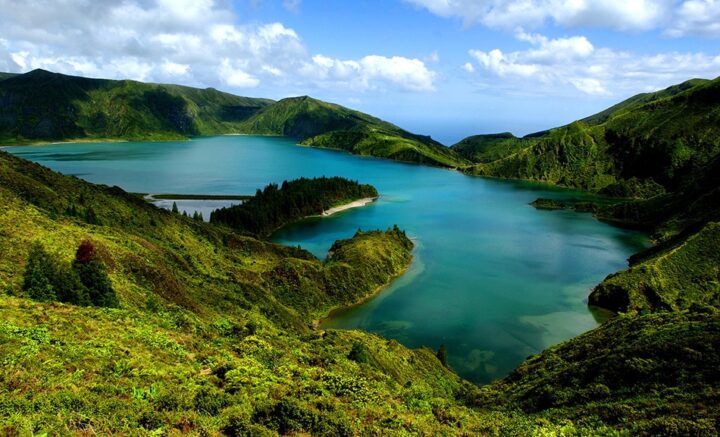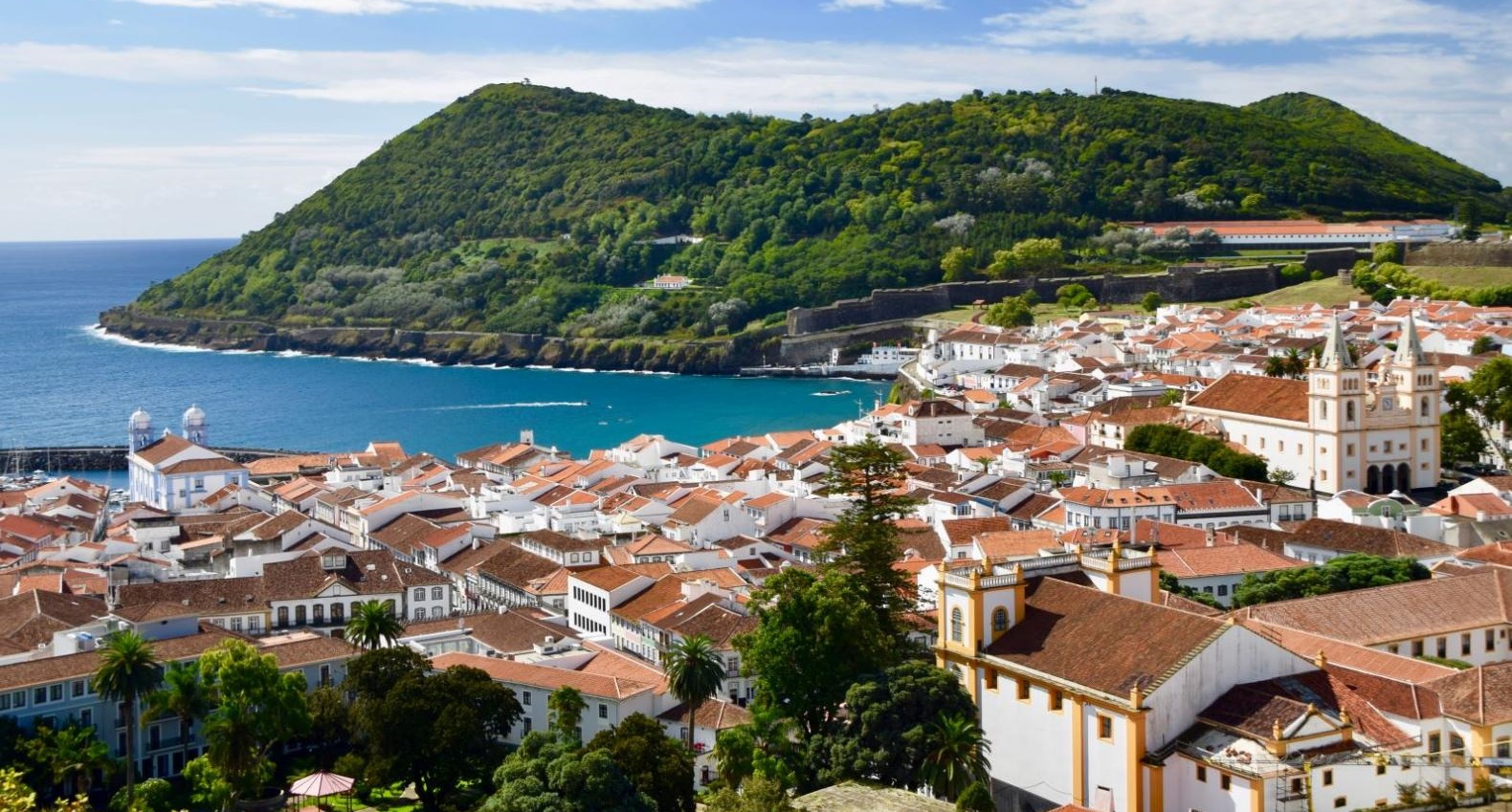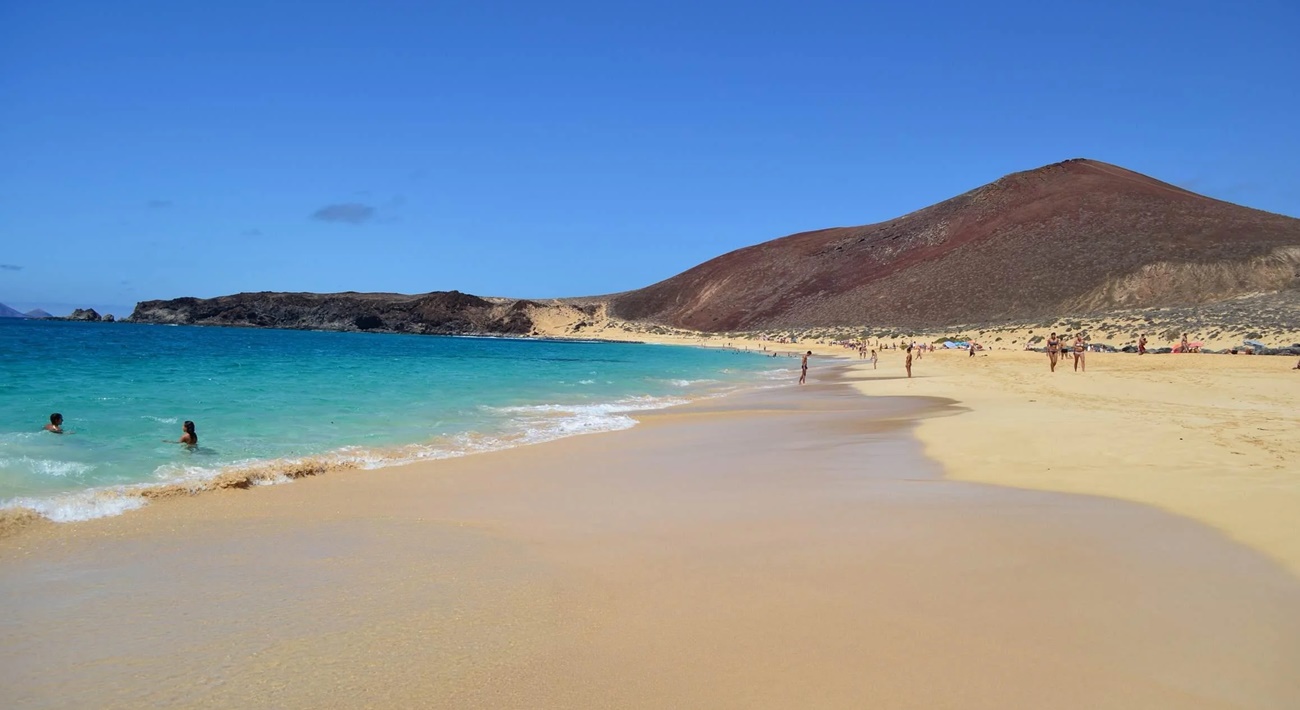
Portugal: Discover the 9 beautiful Azores islands
In the middle of the Atlantic you will find the small paradise of the Azores – we have taken a close look at the archipelago for you!
So close and yet so far: Almost 1400 kilometers from the European mainland are the nine beautiful islands of the autonomous region of the Azores, which officially belong to Portugal and yet are a fascinating kingdom of their own. In our article we introduce you to the unique archipelago!
1. São Miguel Island, Eastern Azores
The first Azores island we want to look at is the largest and at the same time politically most important: the main island of São Miguel, which is also home to the largest city in the archipelago, Ponta Delgada. São Miguel is nicknamed “the green island” and anyone who takes a look at the landscape of the wonderful island will understand why: The island is full of lush green hills and mountain slopes as well as cultivated fields. The landscape is characterized by the mountains in the eastern part of São Miguel as well as by the volcanic craters in the west, especially in the Vale das Furnas valley, where there are also plenty of hot springs. Located on the western south coast of the island, Ponta Delgada serves as the capital of not just São Miguel but the entire Azores. The pretty port city fascinates with its unmistakable black and white houses and serves as the cultural and political center of the region.
2. Santa Maria Island, Eastern Azores
Aside from the small, uninhabited Formigas archipelago, Santa Maria is the second and only other part of the eastern Azores. The idyllic island is the geologically oldest of the Azores and is characterized by green hilly landscapes and white sandy beaches. Santa Maria is inhabited by just over 5,000 people, most of whom live in the main town, Vila do Porto in the southwest of the island. There you will find some interesting historical buildings as well as exciting museums. The true highlight of Santa Maria, however, are the natural landscapes of the island, which is why places like the Ribeira de Maloás, the Gruta do Figueiral or the highest mountain on the island, the Pico Alto, should definitely be on your excursion program when you visit.
3. Pico Island, Central Azores
From the south-east we now go to the central Azores, which consist of a total of five islands and thus represent the largest sub-group of the Azores. The island of Pico is the southernmost island in the region and is primarily known for its – literally – greatest attraction: the volcanic mountain Pico, which not only gives the island its name, but also represents the highest elevation, not only in the Azores, but in all of Portugal . On and around the mountain, which is quite centrally located, you can go on extensive, exciting hikes through the island’s unique natural landscapes – including its black vineyards – before you can go to the cities of the island after all the nature, especially in the capital Madalena on the west coast. The Church of St. Mary and the local Wine Museum are particularly interesting here. From Pico you can also take ferries to the two neighboring Azores islands of Faial and São Jorge and, with a bit of luck, you can also see whales during the trip.
4. Terceira Island, Central Azores

Terceira, the next island in the central Azores, is located in the northeast of the island subgroup and is also the third largest island in the archipelago. Terceira is known for its untamed, deep green landscapes, but also for the oldest city in the Azores, the island’s capital Angra do Heroísmo, which is a UNESCO World Heritage Site. In the city you will find such impressive sights as the Fort of São João Baptista, the Fort of São Sebastião or the Cathedral of the city. Also, just south of Angra do Heroísmo is the Reserva Florestal de Recreio do Monte Brasil, a popular recreational area on the island, and in central Terceira you can visit the fascinating Algar do Carvão, or “Coal Chimney”, a volcanic cave that is open to visitors .
5. São Jorge Island, Central Azores
In the center of the central Azores lies the third island of the group, the island of São Jorge, which should be of particular interest to those who would like to fully immerse themselves in the traditional way of life of the region. São Jorge is long and characterized by impressive steep cliffs and its volcanic hills and mountains, between which there are numerous small villages that can often only be reached on foot. The island is known for its delicious fish dishes and other traditional foods that you should definitely try during your vacation here. In the capital Velas in the west of the island you will find the beautiful natural stone arch Arco Natural de Velas as well as ferry connections to all other central Azores islands. The island’s airport is also in the immediate vicinity, in the neighboring town of Queimada.
6. Faial Island, Central Azores
The westernmost of the central Azores islands is Faial, also known as the Blue Island. However, the name does not come from its wonderful deep blue sea, as one might assume, but from the numerous blue-blossoming hydrangeas that dot the island in summer. Among its natural attractions are primarily the Capelinhos volcano, where you will also find a beautiful lighthouse, and the Cabeço Gordo in the center. To the east of Faial is the capital of the island, the town of Horta, which boasts a beautiful botanical garden, a magnificent marina and the exciting Scrimshaw Museum. From Horta you can also go on whale watching and even whale diving tours, and ferry connections to Pico, São Jorge and the western Azores island of Flores also depart from here.
7. Graciosa Island, Central Azores

At the end of the central Azores we go to the northern and also smallest island of the subgroup as well as to the second smallest island of the entire Azores archipelago: the “lovely” island of Graciosa. Not quite 4,500 people live on Graciosa in just over 60 square kilometers, which are primarily dominated by the mighty caldera, a volcanic crater, in the center. In the caldera you will find a beautiful hiking trail at Furna Do Enxofre Caldeira, which leads you through secured, green-covered gorges, while you can be enchanted along the coast by mighty rocks in the deep blue water. The main town of Graciosa, Santa Cruz Da Graciosa in the north of the island, has an interesting regional museum and a little further along the coast to the east you come to the town of Praia, which not only has its own small offshore island of Graciosa, but from which her You can also take a ferry to the neighboring Azores islands of São Jorge and Terceira.
8. Flores Island, Western Azores
Another 220 kilometers to the west we finally reach the last subgroup of the Azores, the western Azores with the two islands of Flores and Corvo, which geographically already belong to America. The larger of the two, Flores, means “Island of Flowers” and lives up to its name: In spring and summer, the entire island shines in a sea of brightly colored flowers, which in combination with the lush green hills and meadows as well as the idyllic small lakes of the island create a landscape like in paradise. Flores is full of natural attractions that will instantly enchant any lover of unspoiled surroundings, from Poço Ribeira do Ferreiro in the interior of the island to Cascata do Poço do Bacalhau on the coast and Monchique Island off the northwest coast of Flores. Meanwhile, in the island’s capital Santa Cruz Das Flores in the east, some exciting museums and the beautiful monastery of São Boaventura await you, and from Lajes Das Flores in the south there are also ferries to Corvo in the north of the western Azores and to Faial in the central Azores.
9. Corvo Island, Western Azores
And finally we go to the small island of crows, the island of Corvo, north of Flores. With just over 17 square kilometers, the tiny island is the smallest of the Azores islands and is only inhabited by around 500 people. It has only one place, which is simply called Vila do Corvo, ie “Village of Corvo” or “Village of Crows”. Corvo is ideal for those who want above all heavenly peace on holiday, because apart from the beautiful church in the village and the caldera and lake in the north of the island there is not much to see or do here – apart from that, of course, simply during relaxed walks to enjoy the idyllic landscape. From Vila do Corvo you can also take the ferry to Flores Island.
Categories: General
